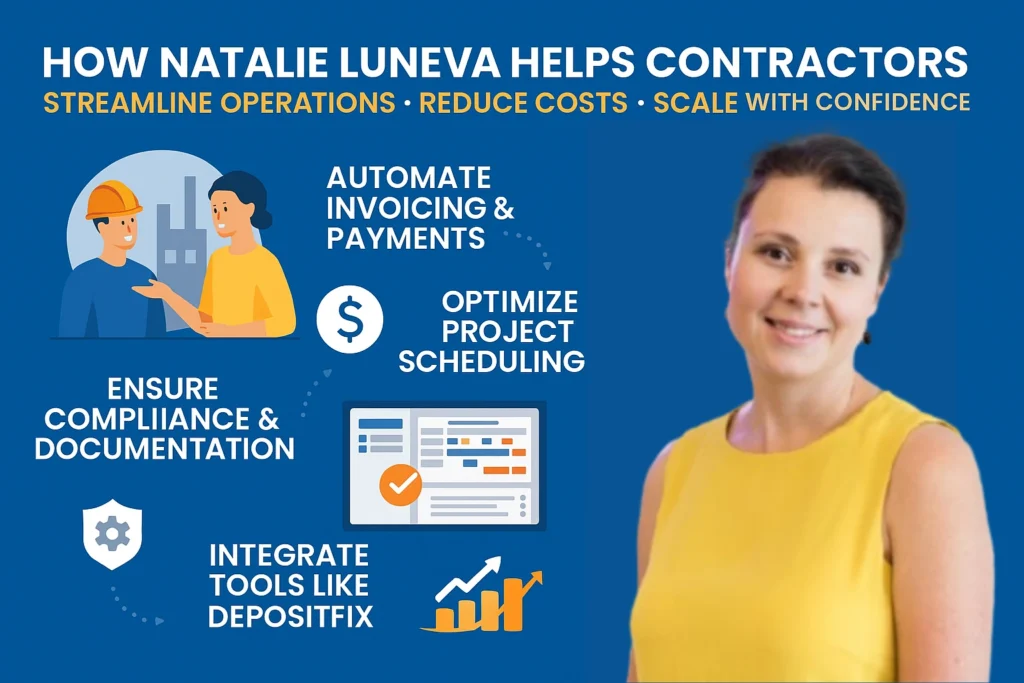Operational Business Process Improvement for Contractors is all about enhancing the way contracting businesses manage their day-to-day operations to become more efficient, cost-effective, and competitive.
For contractors, whether in construction, renovation, plumbing, or electrical services, every project involves multiple moving parts: scheduling crews, managing materials, tracking expenses, coordinating subcontractors, ensuring compliance, and maintaining client satisfaction.
Operational Business Process Improvement focuses on analyzing these processes, identifying inefficiencies or bottlenecks, and implementing strategies or technologies that streamline workflows, reduce waste, and increase productivity.
Key Takeaways
- Targeted change can lift productivity and lower costs quickly.
- A structured approach ties field, office, and subs for fewer delays.
- Planning and measurement speed outcomes and sustain gains.
- Tools like dashboards and standard work keep projects aligned.
- Leadership and clear communication speed adoption across your team.
Why Operational Improvement Matters for Contractors Today
Contractors operate in a market where small delays quickly eat into profit. When permits lag or materials are late, crew idle time and change orders raise costs and lower performance.
Research shows firms that lead in operational improvement see about 25% higher productivity and 20% lower operating costs. Tracking progress doubles the chance of hitting goals compared to ad hoc efforts.
Market pressures, margins, and the cost of delays
Delays show up as lost crew hours, inspection hold-ups, and rework. Those issues erode margins and strain your team.
What research shows about productivity and costs in operations
Data from multiple sectors points to clear results: manufacturers cut production costs up to 30%, and service firms cut delivery times by 40% when they standardize work and reduce variation.
- Faster cycle times boost margins without adding headcount.
- Clear handoffs cut errors and rework.
- Weekly measurement leads to faster corrections and steady results.

Defining Operational Improvement vs. Business Process Improvement
A strategic, company-wide approach helps you turn local fixes into measurable gains. See the big picture: one layer sets priorities and targets that guide which workflows to fix first.
How a company-level approach guides performance
At the top, an integrated method blends Lean and Six Sigma into a repeatable cycle. This level aligns teams, metrics, and governance so gains scale across projects.
Why it matters: clear ownership, timelines, and KPIs ensure changes deliver real productivity and better performance.
Where targeted workflow changes fit
Team-level efforts focus on discrete items: RFIs, submittals, maintenance, or takeoffs. These fixes map to specific steps and cut waste at the source.
- Top-down priorities decide which workflows to tackle first.
- Workflow mapping prevents duplicate effort and conflicting standards.
- Feedback loops let local changes inform company targets and vice versa.
| Scope | Focus | Typical Methods | Outcome |
| Company-level | Alignment, governance, KPIs | Lean, Six Sigma, strategic planning | Scaled gains across projects |
| Workflow-level | Mapping, waste removal, controls | TQM, Agile, BPR, DMAIC | Faster handoffs and fewer errors |
| Interaction | Sequencing and feedback | Pilot tests and rollouts | Measurable uplift in productivity |
The Business Case: Productivity, Costs, and Customer Satisfaction
When schedules slip, the ripple effect hits crews, cash, and client trust.
Quantify the ROI and link fewer errors and faster cycle time to higher productivity and lower operational costs. Firms that focus on targeted improvement report about 25% higher productivity and 20% lower operational costs. Manufacturing examples show up to 30% cost savings; service teams cut delivery time by 40%.
Translate those gains into tangible outcomes for your company.
- Reduced schedule variance and higher bid hit rates improve cash flow.
- Cleaner handoffs and standard work raise milestone performance and customer satisfaction.
- Technology plus consistent steps deliver predictable timelines and fewer errors.
Calculate costs avoided from rework, delivery misses, and idle crews to protect margins in a tight market. Improved field-data capture speeds approvals and shortens time to payment.
| Metric | Typical Gain | Impact |
| Productivity | +25% | Higher throughput per crew |
| Costs | -20% | Stronger margins |
| Delivery time | -40% (services) | Faster client acceptance |
Justify investment in training and connected tools, and tie skill development and sensors to measurable performance and profit. Use examples from other industries to set targets, then adapt them to your field reality to win market share and improve reputation.
Operational Business Process Improvement
A clear five-step cycle helps teams turn everyday work into measurable gains. Use a repeatable, data-led method so wins stack over time and scale across projects.
A cyclical, data-driven approach you can repeat
Assess current performance and map the key steps. Define owners, scope, and the resources and tools each owner needs.
Next, set concise targets and train employees on the new routines. Pilot changes with a small crew and collect data to validate results.
Measure KPIs against your baselines using dashboards. Compare results, gather feedback, and refine steps so gains stick.
- Repeatable steps: assess, set targets, execute, measure, refine.
- Data first: prioritize areas with the largest gaps and track outcomes objectively.
- Adoption: training, coaching, and leadership support speed uptake and reduce risk.
| Phase | Focus | Outcome |
| Assess & target | Baseline data, owners, scope | Clear priorities |
| Execute & measure | Training, tools, dashboards | Validated gains |
| Refine & standardize | Kaizen, SOP updates, scaling | Persistent efficiency |
Close the loop and document lessons, update standard work, and recognize contributors. That keeps momentum and ties every change back to your margins, capacity, and risk targets.
The Core Phases You’ll Use to Improve Current Operations
Trace each handoff so you can spot the steps that slow you down. Map the current state end-to-end and record cycle time, waits, and error rates for field and office tasks.
Assess performance and map processes to find bottlenecks
Walk the workflow with crews and PMs. Capture where time accumulates and where rework starts.
Use root cause analysis to separate symptoms from true constraints so your team targets the few areas that drive most delays.
Set SMART goals aligned to business outcomes
Turn findings into specific targets, such as reduce RFI turnaround 30% in 90 days. Tie each goal to clear metrics and a responsible owner.
Execute changes with training, tools, and clear communication
Roll out new steps with short training, easy-to-use tools, and concise role descriptions. Communicate what changes, who does it, and why it matters.
Measure results, compare to baseline, and gather feedback
Track daily and weekly KPIs against the baseline. Hold quick reviews to correct course fast.
Create feedback loops so crews and PMs report what works and what doesn’t. Use that input to refine the next round.
Refine, standardize, and continue the cycle
Standardize successful changes with SOPs, checklists, and visual controls. Schedule audits to prevent drift and keep consistency across sites.
Scale gains to similar areas in sequenced rollouts. Build a steady cadence so productivity rises and benefits last.
- Assess: map, measure, and root-cause.
- Act: train, equip, and assign roles.
- Measure: compare to baseline and capture feedback.
- Standardize: document, audit, and scale.
| Phase | Primary Focus | Key Metric | Typical Time to See Gains |
| Assess & Map | Cycle times, handoffs, error points | Baseline cycle time (hrs) | 1–3 weeks |
| Execute | Training, tools, role clarity | Turnaround time / error rate | 4–12 weeks |
| Standardize & Scale | SOPs, audits, rollouts | Adoption rate / consistency | 2–6 months |
Building Your Operational Improvement Plan
Begin with a simple plan that links targets, timelines, and who does what. Capture your current baselines first so you can compare gains later.
Baselines, targets, timelines, and resource allocation
Document baseline metrics for time, quality, and costs. Set one clear goal per initiative and a deadline that is realistic.
List required resources, people, tools, and budget, and note who provides each item. Assign owners and define roles for team members and employees so accountabilities are clear.
Risk management, training plans, and stakeholder buy-in
Create a short risk register with mitigations for supply delays, system integrations, and field adoption. Define escalation paths and decision rights to keep schedules on track.
Design a training plan that includes initial sessions, refreshers, and backfill coverage. Use pilots first, then scale successful pilots to limit exposure and validate benefits.
- Communicate: stand-ups and dashboards keep stakeholders and employees aligned.
- Verify: set acceptance criteria and verification steps before standardizing changes.
- Justify: quantify expected benefits versus costs to build a clear internal case.
| Item | Baseline | Target | Owner |
| RFI turnaround | 7 days | 3 days | PM lead |
| Crew idle time | 12% | 6% | Field supervisor |
| Training hours/week | 1 | 3 | Training manager |
Technology, Automation, and Data: The Modern Contractor’s Toolkit
Real-time field data gives you the chance to fix small issues before they become big problems. Connect estimating, scheduling, procurement, and field reporting so entries aren’t duplicated and handoff times shrink.
Digital transformation and connected workflows
Link systems to create a single source of truth. Integrated tools reduce silos and let your team act faster on delays, orders, and approvals.
Automation to cut errors, times, and operational costs
Automate repetitive tasks like submittal routing, timekeeping validation, and daily report consolidation. That lowers manual errors and reduces operational costs while freeing crew hours for value work.
Dashboards, SPC, and advanced analytics for real-time decisions
Use dashboards and SPC to monitor performance and trigger corrective actions. Advanced analytics reveal trends in productivity, safety observations, and punch-list backlogs so you can plan resources proactively.
- Pilot low-code automations to speed deployment and keep governance tight.
- Train crews and admins early to preserve data quality and speed adoption.
- Design role-based views so PMs, supers, and execs each see what matters.
| Capability | What it does | Typical benefit | Example metric |
| IoT field sensors | Capture equipment and environment data | +20% productivity in smart-factory analogs | Uptime %, output/hour |
| Low-code automation | Orchestrate workflows and approvals | Faster deployment and fewer errors | Turnaround time (days) |
| Dashboards & SPC | Real-time monitoring and alerts | Quicker corrective actions, fewer defects | Defect rate / cycle time |
| Integrated ERP/field app | Single data source for estimating to closeout | Less duplicate entry, clearer forecasting | Data entry time saved |
People and Change Management: Engaging Your Team
Getting your crew to own change starts with visible support from leaders on site and in the office. Leadership involvement increases employee buy-in by about 45%, so make sponsorship obvious.
Leadership commitment and department-level champions
Appoint champions in each department to guide employees through changes. Champions bridge crews and managers, clear roadblocks, and keep momentum.
Training, cross-skilling, and communication routines
Design short, practical training and cross-skilling sessions so employee skill grows with each rollout. Companies with strong training programs report higher margins.
Set simple communication rhythms: toolbox talks, brief huddles, and dashboards. Organizations with strong communication strategies see about 23% higher success in improvement efforts.
Pilots, quick wins, and scaling what works
Start with pilots to surface issues and win confidence. Capture quick wins, document resources like coaches and sandboxes, then scale the proven steps.
- Frame changes as benefits: fewer redundant tasks, clearer priorities, safer sites.
- Recognize efforts and celebrate milestones to reinforce new habits.
- Collect feedback and adapt training so adoption spreads cleanly to more crews.
| Role | Focus | Outcome |
| Leader | Visibility & decisions | Higher employee buy-in |
| Champion | Coaching & troubleshooting | Faster adoption |
| Supervisor | Daily mentoring | Sustained change |
Measuring What Matters: KPIs, Quality, and Time-to-Value
Good measurement turns noisy activity into clear signals you can act on fast. Choose a small set of KPIs that tie to a clear goal and an owner. Mix leading indicators, like schedule adherence, with lagging results such as rework rate.
Choosing KPIs for productivity, quality, costs, and satisfaction
Define KPIs for productivity, quality, cost, safety, and customer satisfaction. Link each metric to a single owner so reviews trigger fixes not blame. Use crew- and trade-level segmentation so coaching targets the right team.
Designing dashboards that drive action
Build dashboards that show real-time data, historical trends, target vs. actual, and alerts. Add drill-downs and SPC charts to spot variation early. Publish simple scorecards for employees and supervisors to sustain focus.
- Set baselines, thresholds, and escalation rules.
- Integrate field feedback and customer signals into reviews.
- Measure time-to-value so you know when to scale.
| KPI | Type | Use |
| Schedule adherence | Leading | Daily alerts for crews |
| Rework rate | Lagging | Root cause & training focus |
| Client acceptance time | Outcome | Time-to-value & satisfaction |
Update metrics, dashboards, and tools as your approach and priorities evolve. Regular feedback keeps results visible and employees engaged.
Applying the Playbook to Contracting: Examples and Workflows
Small changes to common workflows can cut errors and speed delivery on your projects. Examples from banking and healthcare show this works: approvals moved from weeks to days and discharge times fell 45% after mapping and checks.
From estimating to closeout: eliminating rework and errors
Map your estimating workflow to reduce takeoff errors and standardize assumptions. That lowers bid risk and change order exposure.
Use templates and routing rules to speed submittals and RFIs, cutting cycle times and preventing delays.
Inventory, scheduling, and field communication improvements
Set min/max inventory thresholds and scanning tools so materials arrive when needed.
Integrate lookahead schedules with procurement and labor to tighten times and reliability.
Upgrade field communication with mobile checklists and photos to close quality gaps and cut rework.
Safety, quality control, and customer satisfaction boosts
- Build QA/QC hold points to catch defects early and reduce punch lists.
- Link safety observations to corrective tasks to lower incidents and keep your team focused.
- Deliver clear status updates and predictable closeout packages to raise customer satisfaction.
| Area | Action | Benefit |
| Estimating | Standard assumptions & templates | Fewer errors, lower bid risk |
| Inventory | Min/max and scans | Materials on-site, less delay |
| Field | Mobile checklists & photos | Less rework, higher quality |
Overcoming Obstacles and Sustaining Improvements
Limited budgets and old systems can stall progress unless you plan phased work. Over half of change efforts fail; only about 34% finish successfully. Planning, visible sponsorship, and small pilots keep the momentum.
Budget constraints, legacy systems, and integration issues
Phase investments so you prove value before scaling. Start with pilots that require little spend but show measurable gains.
Prioritize a few system connections that unlock the most value first. That reduces risk and keeps integrations manageable.
Resistance to change and momentum loss
Reduce resistance with clear communication, short training sessions, and visible leadership support. Leadership boosts buy-in by about 45% and helps crews adopt new routines.
Celebrate quick wins and pace efforts so morale stays high and momentum doesn’t fade.
Governance, reviews, and continuous learning for long-term gains
Stand up light governance: charters, decision rights, and escalation paths to prevent gridlock. Use monthly reviews and quarterly adjustments to keep plans aligned with field realities like workload and weather.
- Document new processes and add short refresher training to prevent drift.
- Keep focus on outcomes, not activity, so the organization sustains what matters.
- Use consistent updates to surface issues early and fix them before they grow.
| Obstacle | Mitigation | Who | Timing |
| Budget limits | Phased pilots with clear ROI | Project lead & finance | 30–90 days |
| Legacy systems | Prioritize key integrations | IT & PM | 60–180 days |
| Resistance | Communication, training, visible sponsor | Leadership & champions | Ongoing |
| Momentum loss | Regular reviews, celebrate wins | Program sponsor | Monthly |
Improve Your Operational Business Process with Natalie Luneva
If your contracting business is struggling with administrative chaos, missed payments, or inefficient scheduling, Natalie Luneva provides expert guidance to streamline your operations along with DepositFix. She helps contractors optimize workflows, reduce costs, and scale their businesses effectively.
With over a decade of experience in marketing, operations, and business strategy, Natalie offers hands-on solutions that go beyond advice, delivering measurable results. Here’s how she can help contractors improve their operational business processes:
- Streamline invoicing and payments: Automate billing, reduce errors, and improve cash flow for your trade business.
- Optimize project scheduling: Efficiently manage crews, subcontractors, and timelines for smoother project delivery.
- Enhance marketing and client acquisition: Implement strategies that attract more clients while maintaining operational efficiency.
- Ensure compliance and documentation: Maintain proper records, reduce legal risks, and standardize workflows.
- Integrate proven tools and systems: Leverage software solutions like DepositFix to manage operations, invoicing, and payments in one place.
- Reduce operational costs: Identify inefficiencies and implement processes that save time and money.
- Scale your business with confidence: Build repeatable processes that support growth without increasing chaos.
Natalie Luneva combines strategic oversight with hands-on execution and acts as an outsourced CFO, CMO, COO, and CTO for contractors, helping them move from operational chaos to controlled, profitable growth. Book a strategic call today to discover how she can transform your business operations.

Conclusion
Turn everyday fixes into lasting advantage and link targets, training, and timely measurement. Adopt a simple roadmap you can follow each week and let small wins compound into real gains for your team and company.
You’ll leave with a practical plan to raise productivity, efficiency, and predictability across operations. Commit to short pilots, measure against baselines, and scale what works while retiring what doesn’t.
Invest in people, technology, and clear metrics in balance. That approach sustains growth, sharpens performance, and delivers better customer outcomes over time.
With expert guidance from Natalie Luneva, your business can move from reactive problem-solving to proactive management, ensuring every project runs smoothly and profitably.
FAQs
What is the difference between operational improvement and digital transformation for contractors?
Operational improvement focuses on streamlining workflows, reducing waste, and enhancing processes. Digital transformation includes adopting technology to automate tasks and create new ways of delivering services. Together, they maximize efficiency and growth.
How long does it typically take to see results from operational process improvements?
While some quick wins like schedule optimization or invoice automation can show results in 4–12 weeks, full-scale improvements usually take 3–6 months, depending on the size of your business and the complexity of processes.
Can small contracting businesses benefit from operational business process improvement?
Yes. Even small teams can reduce wasted time, improve cash flow, and increase customer satisfaction with the adoption of structured processes and leveraging affordable tools like DepositFix.
Can operational improvements help improve profit margins?
Yes. With reduced delays, minimized rework, optimized scheduling, and improved cash flow, operational improvements directly contribute to stronger profit margins.


